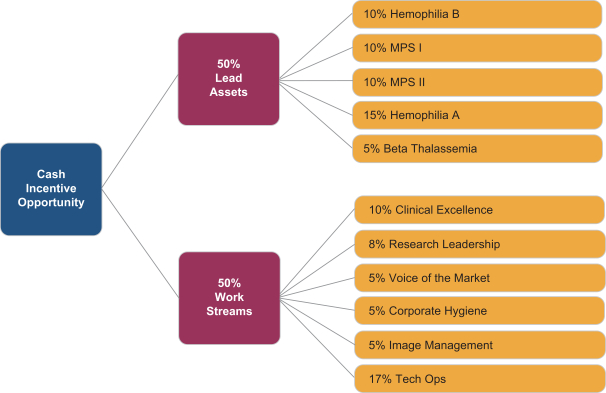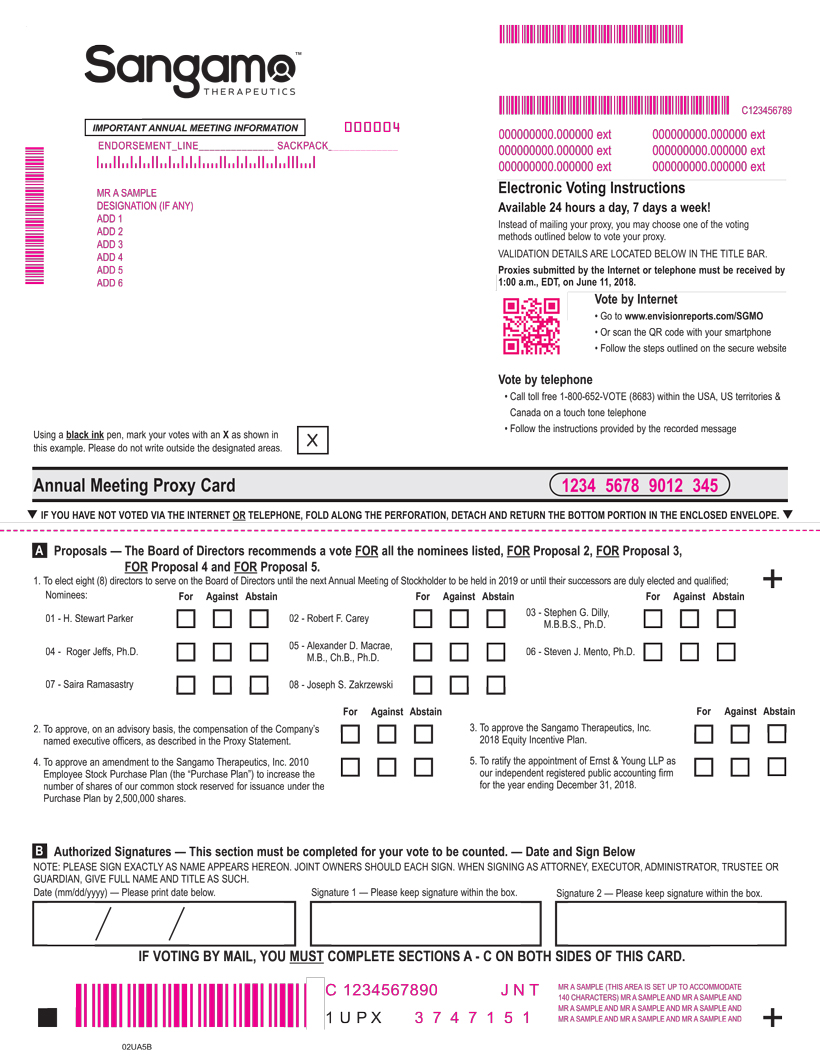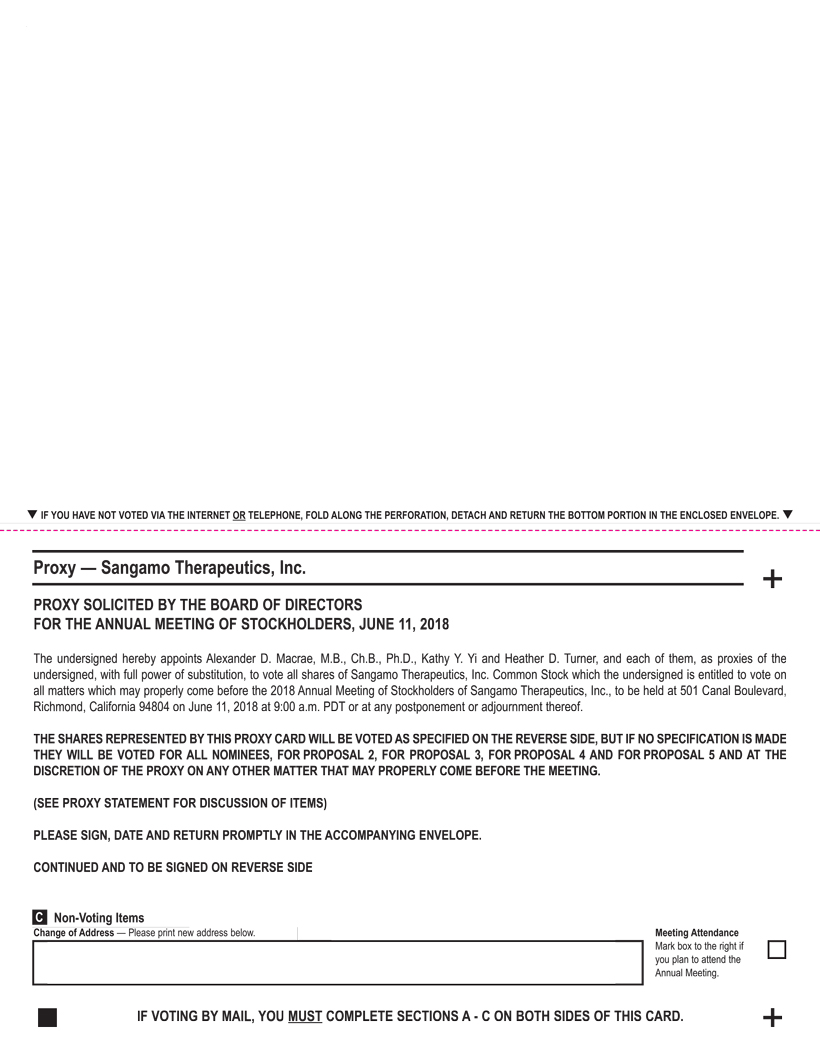and gastroenterology. Dr. Macrae received his B.Sc. in pharmacology and his M.B., Ch.B. with honors from Glasgow University. He currently serves on the board of directorsis a member of the Biotechnology Institute, the boardRoyal College of directorsPhysicians. Dr. Macrae also earned his Ph.D. in molecular genomics at King’s College, Cambridge. The Nominating and as Chairman of the Alliance for Regenerative Medicine, the board of trustees for The Buck Institute for Research on AgingCorporate Governance Committee and the Dean’s Advisory Board of the University of Michigan School of Public Health. Mr. Lanphier received a B.A. in biochemistry from Knox College. Mr. Lanphier brings extensive experience in executive management of biotechnology companies focused on the therapeutic development of biologics. In addition, Mr. Lanphier’s believe that Dr. Macrae’sday-to-day leadership and intimate knowledge of Sangamo’sour business and operations, as well as Sangamo’sour relationships with partners, collaborators and investors, provide the Board with anin-depth understanding of the Company.
Robert F. Carey, age 57, is59, has served as a new director nominee.member of our Board of Directors since June 2016. Mr. Carey has been executive vice president, chief business officer for Horizon Pharma plc, a biopharmaceutical company, since March 2014. Prior to that, he served as managing director and head of the healthcare investment banking group at JMP Securities LLC, a full-service investment bank from March 2003 to March 2014. Prior to JMP, Mr. Carey was a managing director in the healthcare groups at Dresdner Kleinwort Wasserstein and Vector Securities International, Inc. He has also held roles at Shearson Lehman Hutton and Ernst & Whinney. Mr. Carey has served on the board of directors of Argos Therapeutics,
4
Inc., a life science company, since September 2015. Mr. Carey received his B.S. in accounting from the University of Notre Dame. The Nominating and Corporate Governance Committee and the Board believe that Mr. Carey’s extensive experience in, and knowledge of,in the healthcare investment banking industry, particularly with regards to financings, global expansion and other strategic transactions involving life scienceby life-science companies, as well as his role as a senior executive leading thein business development efforts for a public commercial biopharmaceutical company, will provide the Board with valuable insight and contribution.
Paul B. Cleveland, age 59, has served as a member of our Board of Directors since November 2008. Since November 2015 Mr. Cleveland has served as President, CEO and a member of the board of directors of Avalanche Biotechnologies, Inc. From June 2015 to November 2015, he was President, CEO and a member of the board of directors of Celladon Corporation, an AAV cardiovascular gene therapy company. From June 2014 to June 2015, he was President and CFO of Celladon Corporation. From February 2013 to August 2013, he was Executive Vice President, Corporate Strategy and Chief Financial Officer of Aragon Pharmaceuticals, a private biotechnology company focused on the development of small-molecule drugs for the treatment of hormone-dependent cancers. From April 2011 through February 2013, he served as General Partner and Chief Operating Officer of Mohr Davidow Ventures. From January 2006 through February 2011, Mr. Cleveland served as Executive Vice President, Corporate Development and Chief Financial Officer of Affymax, Inc., a biopharmaceutical company. From April 2004 to December 2005, he served as a Managing Director at Integrated Finance, Ltd., an investment bank. From September 1996 to April 2003, he served as a Managing Director at J.P. Morgan Chase and Co. (and a predecessor firm, Hambrecht & Quist), an investment bank. From January 1993 to September 1996, he was a partner at Cooley Godward LLP, a law firm. From December 1988 to December 1992, he was a corporate attorney at Sidley Austin LLP, a law firm, and from September 1981 to November 1988, he was a corporate attorney at Davis Polk & Wardwell, a law firm. Mr. Cleveland received a J.D. from Northwestern University School of Law and an A.B. from Washington University in St. Louis. Mr. Cleveland brings extensive experience in the areas of finance, investment banking and corporate and securities law to our Board. His experience as the President and Chief Executive Officer and as Chief Financial Officer of several biotechnology companies also provides additional insight to the Board on the operational, financial issues and best practices of such companies.
Stephen G. Dilly, M.B.B.S., Ph.D., age 56,58, has served as a member of our Board of Directors since March 2010. Since May 2014, Dr. Dilly has served as Chief Executive Officer and a member of the board of directors of Aimmune Therapeutics, Inc. (formerly Allergen Research Corporation), a biotechnology company developing treatments for food allergies. From January 2012 to December 2012, he was Chief Executive Officer of PhotoThera, Inc., a medical device company. From 2006 to December 2011, he served as President and Chief Executive Officer and a member of the board of directors of APT Pharmaceuticals, Inc., a drug development company. From 2007 to 2009, he served as a member of the board of directors of Avigen, Inc., a biopharmaceutical company whichthat merged with MediciNova, Inc. in December 2009. From 2003 to 2006, he served as Chief Medical Officer and Senior Vice President of Development of Chiron BioPharma, a biotechnology company whichthat was later acquired by Novartis International AG. From 1998 to 2003, he held various management positions at Genentech, Inc., including Vice President of Development Sciences from 2002 to 2003 and Vice President of Medical Affairs from 1998 to 2001. From 1988 to 1998, Dr. Dilly held various management positions in drug development with SmithKline Beecham in the U.K. During his career, Dr. Dilly has been closely associated with the development and launch of marketed drugs for many therapeutic areas, including Kytril, Paxil, Kredex, Requip, TNKase, Xolair, Avastin, Raptiva, Tarceva, Lucentis and Cubicin. In 1982 Dr. Dilly received an M.B.B.S., the equivalent of an M.D. in the U.S.,United States, from the University of London in the U.K. and a Ph.D. in cardiac physiology from University of London in 1988. Dr. Dilly brings medical expertise and significant drug development experience to our Board. The Nominating and Corporate Governance Committee and the Board believe that Dr. Dilly’s extensive experience in all stages of drug development, from project prioritization through clinical trial design and data analysis to product launch, provides the Board with valuable insight into this process as the Company continues to advance and develop our ZFP Therapeutic pipeline.pipeline of novel genomic and cell therapy assets.
Roger Jeffs, Ph.D.,age 56, has served as a member of our Board of Directors since June 2017. Prior to his retirement in 2016, Dr. Jeffs served as President andco-Chief Executive Officer of United Therapeutics Corp., where he worked for 18 years, joining the company in itsstart-up phase in 1998 as Director, Research, Development and Medical and serving as President and Chief Operating Officer from 2001 to 2014. He has over 25 years of experience in the biopharmaceutical industry in R&D, clinical development, regulatory and medical affairs. While at United Therapeutics, Dr. Jeffs led the clinical development, regulatory approval and commercialization of six rare disease products and managed the commercial effort that led to a greater than 20% compound annual growth rate (CAGR) and $1.5 billion annual revenue run rate. Prior to joining United Therapeutics, he held positions in clinical development at Amgen, Inc. and Burroughs Wellcome Co. Dr. Jeffs currently also serves as a












